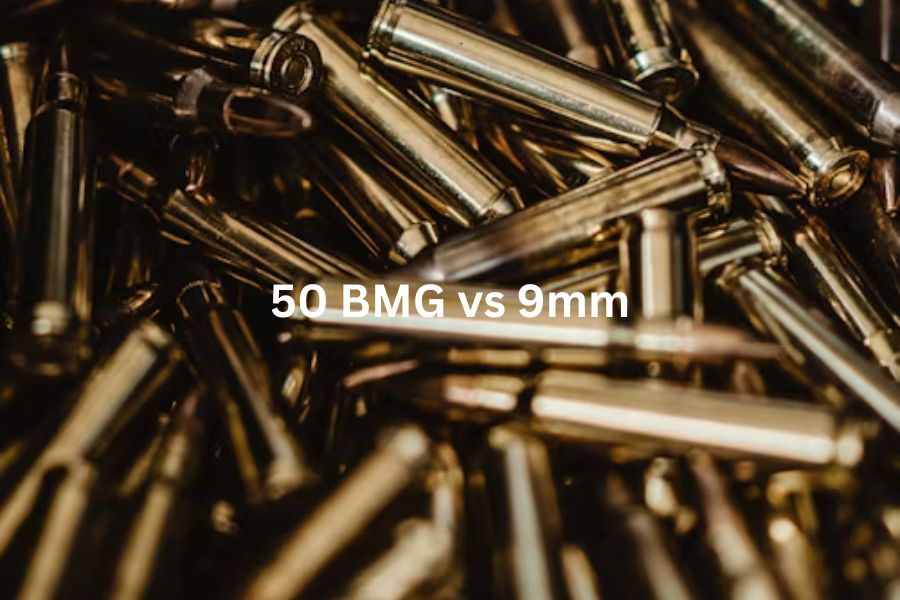Regarding firearm cartridges, the 9mm and the 50 BMG represent two ends of the spectrum in terms of size, power, and application. The 9mm, is a handgun cartridge and the 50 BMG is a heavy-hitting rifle cartridge. But just how do these cartridges differ? And by how much?
Here is the short answer:
The 9mm is a compact and versatile handgun cartridge commonly used for self-defense, target shooting, and military and law enforcement applications. 50 BMG is a massive rifle cartridge primarily used in heavy machine guns and long-range sniper rifles.
In-Depth Look at the 9mm
The 9mm cartridge was introduced in 1902 by the German firearms manufacturer DWM for use in the Luger semi-automatic pistol. It features a rimless, tapered case with a bullet diameter of 9 millimeters and a case length of 19 millimeters hence the alternate name 9x19mm.
The 9mm is renowned for its widespread adoption by military and law enforcement agencies worldwide, as well as its popularity among civilian shooters. It offers a good balance of terminal performance, magazine capacity, and controllable recoil, making it suitable for various applications, including self-defense, concealed carry, target shooting, and competition.
The only downside to the 9mm is that it is not as powerful as some of the larger pistol calibers such as the 40 S&W or the 45 ACP.
Here is a ballistics chart of the 9mm 124-grain jacketed hollow point:
| range (YD) | drop (IN) | wind drift (IN) | velocity FPS | energy ft-lb |
| 0 | -0.9 | 0 | 1150 | 364 |
| 25 | 0.5 | 0.3 | 1095 | 330 |
| 50 | 0 | 1.1 | 1049 | 303 |
| 75 | -2.4 | 2.5 | 1010 | 281 |
| 100 | -7 | 4.3 | 977 | 263 |
| 125 | -13.8 | 6.6 | 948 | 247 |
| 150 | -23 | 9.2 | 921 | 234 |
| 175 | -34.8 | 12.3 | 897 | 221 |
| 200 | -49.1 | 15.6 | 874 | 210 |
In-Depth Look at the 50 BMG
The 50 BMG cartridge was developed by John Browning in the early 20th century for use in heavy machine guns. It features a rimless, bottlenecked case with a bullet diameter of .510 inches (12.95 millimeters) and a case length of 3.91 inches (99 millimeters).
The 50 BMG is one of the most powerful rifle cartridges in the world, capable of delivering copious kinetic energy and long-range accuracy. It is primarily used in military applications for engaging vehicles, and equipment at extreme distances. In civilian hands, the 50 BMG is almost exclusively used for long-range target shooting.
Here is a ballistics chart of the 50 BMG with a 750-grain Hornady A-max bullet:
| range (YD) | drop (IN) | wind drift (IN) | velocity FPS | energy ft-lb |
| 0 | -1.5 | 0 | 2820 | 13242 |
| 50 | -0.2 | 0.1 | 2774 | 12810 |
| 100 | 0 | 0.4 | 2728 | 12389 |
| 150 | -1 | 0.8 | 2682 | 11980 |
| 200 | -3.2 | 1.4 | 2637 | 11582 |
| 250 | -6.6 | 2.1 | 2593 | 11194 |
| 300 | -11.4 | 3 | 2549 | 10816 |
| 350 | -17.4 | 4 | 2505 | 10448 |
| 400 | -24.8 | 5.3 | 2462 | 10091 |
| 450 | -33.6 | 6.7 | 2419 | 9742 |
| 500 | -44 | 8.3 | 2376 | 9403 |
In-Depth Comparison
Size and Power: The 50 BMG is significantly larger and more powerful than the 9mm. There really is no comparison in terms of size and power because these two rounds are just so different. The 50 BMG has nearly 13000 more foot pounds of energy than the 9mm and is 80mm (3.15 inches) longer in case length.
Recoil and Shootability: Due to its smaller size and lower powder capacity, the 9mm generates far less recoil than the 50 BMG. Additionally, the 9mm is far cheaper to shoot, about 9-10 dollars cheaper per round. So if you want to be able to shoot on a somewhat freqent basis, the 9mm is by far the better choice. This is not to mention that most 50 BMG rifles cost nearly 10,000 dollars while a 9mm carbine can be found for as little as 500 dollars.
Application: The 9mm is primarily used in handguns or PCCs (Pistol Caliber Carbines) for self-defense, law enforcement, and target shooting at close-range. On the extreme other end, the 50 BMG is employed in heavy machine guns and long-range precision rifles.
Conclusion
In conclusion, the 9mm and the 50 BMG represent two distinct ends of the spectrum in about every way imaginable. The 9mm is a short-range self-defense and cheap plinking cartridge while the 50 BMG is an extremely expensive long-range percersision cartridge. So unless you have endless funds or a very specific long range shooting applications, the 9mm is the better option.

